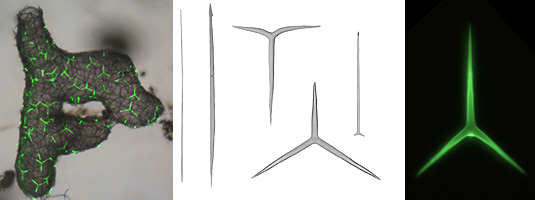Biomineralization of calcareous sponges
Research Oliver Voigt
Many animals can form skeletal elements by the controlled precipitation of minerals. Calcareous sponges are the only sponges that form calcitic spicules, while spicules of demosponges, hexactinellids and homoscleromorphs are siliceous. The formation of calcareous sponge spicules involves only a few specialized cells (sclerocytes), and different types of spicules can be produced within a sponge. This makes these animals an ideal system to study how biominerals are formed. In my research, I want to understand the genetic mechanisms that control the biomineralization process, and how they evolved.

Key Publications
Voigt O, Fradusco B, Gut C, Kevrekidis C, Vargas S, Wörheide G (2021): Carbonic anhydrases: An ancient tool in calcareous sponge biomineralization. Frontiers in Genetics 12:383. Full text
Voigt O, Adamska M, Adamsiki M, Kittelmann A, Wencker L, Wörheide G (2017): Spicule formation in calcareous sponges: Coordinated expression of biomineralization genes and spicule-type specific genes. Scientific Reports 7:45658. Full text
Voigt O, Adamski M, Sluzek K & Adamska M (2014): Calcareous sponge genomes reveal complex evolution of alpha-carbonic anhydrases and two key biomineralization enzymes. BMC Evolutionary Biology 14: 230. Full text





